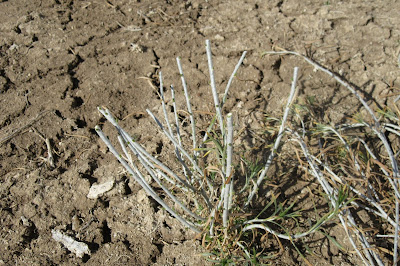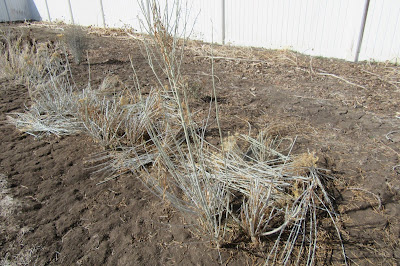 |
| Meadow Onion (Allium unifolium): late spring |
There’s
not much going on in our Zone 6 garden in early March. But some of the bulbs we
planted last fall are starting to break ground, including Allium unifolium.
So we decided to feature this lovely true bulb as our Plant of the Month. The scientific name is pronounced: AL-ee-um
yu-nee-FOE-lee-um.
The
Meadow onion is not native to Colorado.
It grows along the Central and Northern coast of California, from San
Luis Obispo County into Oregon, and also in Baja California. It grows in moist, often grassy areas on
coastal cliffs in the coastal pine and mixed evergreen forests. It tolerates moist soils and is most
comfortable in clay. These two
preferences make it a good choice for many gardens.
 |
| Meadow Onion (Allium unifolium): bulbs |
Allium unifolium is a true onion (genus Allium), a cousin to our culinary onions
and garlic. The onions were formerly
included in a large bulb-forming family, the Lilliaceae. Some taxonomists
now recommend placing the onions in their own family, the Alliaceae. Others place the onions in the Amaryllis Family (Amaryllidaceae), along with such garden
genera as Agapanthus, Amaryllis, Clivia, Narcissis and Zephyranthes. Only
time will tell where the Alliums will end up.
Colorado
has about ten different species of native Alliums. The vast majority grow on the Western Slope,
usually above about 5000 ft elevation. Six
are native to Montrose County but most are difficult to find, even as seeds.
Fortunately for Western gardeners, some non-local species can succeed in local
gardens – if only you can find a source for the bulbs! Fortunately, Allium unifolium is
available even from some traditional bulb growers like Van Engelen Inc. (it’s a
favorite in European gardens!).
 |
| Meadow Onion (Allium unifolium): early spring |
Like
most Alliums, Meadow onion is a fairly
simple perennial. Its leaves emerge from
the bulb with the late winter rains. We
often see them start to emerge in February in our garden. The leaves are the simple, strap-like leaves
of the onions. The genus name unifolium mean ‘single-leaf’; in fact,
another name for this plant is the One-leaf onion. As seen above, plants are indeed sparsely
leaved (one to four leaves is typical).
 |
| Meadow Onion (Allium unifolium): flower bud |
The
leaves often start to wither from the tips (and sometimes wither altogether)
before the flowers emerge. Meadow onion
blooms in spring or early summer: usually April or May, but a bit later in
colder climates. The flowers grow in dense
clusters (umbels) on 1-2 foot (30-45 cm) flowering stalks. If you live in a dry
place like much of Western Colorado, the flowering stalks may be a little
shorter. The buds are tightly packed in
a membranous sheath (see above) at the tip of the growing flower stalk. The stalks grow very quickly to their full
height.
 |
| Meadow Onion (Allium unifolium): floral cluster |
Meadow
onion has the star- or bell-shaped flowers typical of the onions. The six veined ‘petals’ are actually tepals
(petals and sepals look alike). The
flowers are individually small (about ½ an inch across), but with 15 or more
flowers per umbel, this onion is a showy bloomer. The flower color is most often a pale
lavender or pale pink, though white-flowering forms are known.
 |
| Meadow Onion (Allium unifolium): flowers |
The
flowers contain both male and female parts (‘perfect’ flowers). The pollen in this species is either gray or
yellow. The plants produce seeds in our
garden, so they do attract some insect pollinators with their mildly sweet
aroma. While the literature specifies
bees as pollinators, we more often see the flower flies (below).
 |
| Meadow Onion (Allium unifolium): flowerfly (pollinator) |
Allium
unifolium is easy to grow.
It can be grown in just about any soil, although it prefers the
moisture-retaining clays. It needs a
neutral to alkali soil (pH 7.0-9.0). While it grows in full sun in Oregon,
gardeners in warmer climates should plant this species in part shade (afternoon
shade to fairly shady). This plant does
need good winter/early spring rains. We sometimes
have to supplement ours in dry winters.
Unlike some native bulbs, this species can take occasional summer water.
We
let our plants go to seed, then let them self-seed naturally (or spread them
where we want to start a new patch).
Patches increase slowly both by seed and by offsets (new little
bulbs). A modest investment in bulbs
will increase to a nice grouping within 4-5 years. We like to start out by planting 8-10 bulbs
within a 2 square foot area. Don’t
worry about critters digging up the bulbs – they tend to leave onions alone.
For more on planting bulbs see: https://mothernaturesmontrosegarden.blogspot.com/2020/10/gardening-tip-planting-native-flower.html
 |
| Meadow Onion (Allium unifolium): in garden |
We
love the flowers of this onion. The
color contrasts nicely with native grasses and wildflowers. It’s great for brightening shady areas of the
garden, for example, under trees. The
plants naturalize nicely, and can help ‘tie together’ parts of the garden with
their pastel leaves and flowers.
Bulbs
are a perfect choice for bordering pathways, as an accent plant in a rock
garden or along a garden wall. Meadow onion’s flowers have a light, sweet
fragrance, making them a good choice for containers near seating areas and as cut
flowers. This bulb would do well around
the drier edges of a vegetable garden or in an herb garden. Native Californians did not eat it; however, at
least one blogger uses the stems as a flavoring agent [ref. 1, below].
 |
| Meadow Onion (Allium unifolium): with other wildflowers |
So
why include Meadow onion in your garden?
First, it’s easy to grow and available from bulb dealers. Second, it’s a little charmer that’s adaptable
to garden challenges like clay soil and a bit of shade. Thirdly, it provides an economical solution
to providing masses of spring color – or to naturalize.
If
you desire, Allium unifolium can be used as a flavoring agent. The flavor is similar to that of garden
onions – perhaps even better. All parts are edible, including the flowers (in a
salad or as a garnish), leaves, flowering stems and bulb. Consider growing this
in the vegetable garden, along with your chives or garlic-chives.
And
finally, Meadow onion has all the magic of a native perennial bulb. It gives you something to look forward to,
without much care, year after year. It’s
a seasonal treat, anticipated and enjoyed, that ties us to the land and its
seasons. We echo many previous garden
mavens, in singing the praises of garden bulbs.
For more on
gardening with native bulbs see: https://mothernaturesmontrosegarden.blogspot.com/2020/10/gardening-tip-planting-native-flower.html
For a
gardening information sheet see: Co
gardening sheet allium unifolium (slideshare.net)
For more
pictures of this plant see: http://www.slideshare.net/cvadheim/allium-unifolium-web-show
For plant
information sheets on other Western native plants see: http://nativeplantscsudh.blogspot.com/p/gallery-of-native-plants_17.html
________________
- http://lilliehouse.blogspot.com/2015/06/permaculture-plants-allium-unifolium.html
__________________________________________________________
We welcome your comments
(below). You can also send your
questions to: monaturesmontrosegarden@gmail.com


















